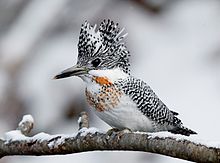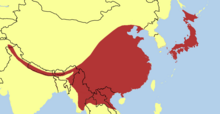Megaceryle lugubris
| Crested kingfisher | |
|---|---|
 |
|
 |
|
| Male and female M. lugubris subsp. pallida at Asahikawa city in Japan | |
| Scientific classification | |
| Kingdom: | Animalia |
| Phylum: | Chordata |
| Class: | Aves |
| Order: | Coraciiformes |
| Family: | Alcedinidae |
| Subfamily: | Cerylinae |
| Genus: | Megaceryle |
| Species: | M. lugubris |
| Binomial name | |
|
Megaceryle lugubris (Temminck, 1834) |
|
 |
|
| approximate distribution | |
The crested kingfisher (Megaceryle lugubris) is a very large kingfisher that is native to parts of southern Asia, stretching eastwards from the Indian Subcontinent towards Japan. It forms a species complex with the other three Megaceryle species.
The first formal description of the crested kingfisher was by the Dutch zoologist Coenraad Jacob Temminck in 1834 under the binomial name Alcedo lugubris. The current genus Megaceryle was erected by the German naturalist Johann Jakob Kaup in 1848.Megaceryle is from the Ancient Greek megas, "great", and the existing genus Ceryle. The specific name lugubris is the Latin word for "mournful".
There are four subspecies:
The crested kingfisher is a very large 41–43 cm (16–17 in) black and white kingfisher with a shaggy crest. It has evenly barred wings and tail. It lacks a supercilium and has a spotted breast, which is sometimes mixed with rufous.
It is resident in the Himalayas and mountain foothills of northern India, Bangladesh, northern Indochina, Southeast Asia and Japan. This bird is mainly found in mountain rivers and larger rivers in the foothills of mountains.
The nest is a burrow excavated into a vertical bank in a forest. It can be by a stream or a ravine or can be up to 1.5 km (0.93 mi) away from water. The burrow is dug by both sexes using their feet and bills. It is 10–15 cm (3.9–5.9 in) wide and 2–3 m (6 ft 7 in–9 ft 10 in) in length. The clutch of 4-7 eggs is incubated only by the female. The nestlings are fed by both parents for around 40 days before they fledge.
...
Wikipedia

